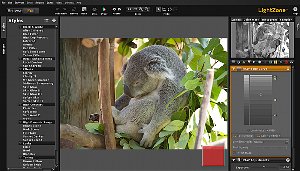Author: Nathan Willis
We reviewed the RAW photo editor LightZone almost a year ago, when the Linux version of the product was a closed source — but free — download. After months of updates only for the Mac OS X and Windows versions of the application, Light Crafts has released a new beta for Linux. It is a substantial improvement — but it also marks the end of the road for the free edition.
You can download the LightZone 3.3 beta from the Try LightZone page on the corporate site. The company offers basic info on the Linux edition, and recommends that you have at least Java 1.5 installed in order to run LightZone.
The 3.3 beta is limited to a 35-day trial period, but does not lock out any of the application’s features. The download is a 56MB tar archive; because the app is Java-based, you can unpack and run it from anywhere with the command sh ./LightZone.
If you have been using the older, free edition of LightZone for Linux, you may want to rename your installation’s directory before trying out the 3.3 beta; the new version will attempt to overwrite previous versions, and that could make reverting back to the free version difficult or impossible. You can keep multiple versions of LightZone installed simultaneously, but they must be in separate directories.
New and improved
LightZone’s interface has changed substantially since version 2.4. On the surface, it has adopted the dark stylings popularized by Adobe Lightroom and Apple Aperture. The tools and menus have also been reorganized. Previous versions grouped some transformation and editing tools into two different places; they are now all together, which makes finding the one you need faster.
I was also pleased with the repositioning of image metadata in Browse mode; it has moved from the lower left corner beneath the file and directory tree to the top level on the right side. For users that read top-to-bottom, it is easier to jump to visually, and having a full column all to itself means more info fits on screen without users having to mouse over and scroll.
Two big new additions to this version are Styles and Re-Light. Styles are pre-made image adjustments that you can apply with one click. They range from subtle warmth adjustments to simulation of black-and-white film taken through different on-camera filters. They are easy to apply, and you can preview the effects instantly.
As with all of LightZone’s adjustment tools, when you apply a style it appears in the stack of adjustments on the right side of the window. You can activate and deactivate them at will, without losing any of the other changes you make to the image.
Re-Light is akin to the “auto fill-light” feature found in many RAW converters; it intelligently brightens underexposed areas and darkens overexposed areas without losing detail. Of course, that same degree of panacea is touted by all such automatic image correction tools — the real test is how well it performs on actual images.
I was pleased with the Re-Light’s results, particularly on underexposures. More importantly, the tool’s manual controls make adjusting the effect easier. Some “auto fill-light” tools work their magic in a single shot, and if you don’t like the result, your only option is to Ctrl-Z Undo it and try something else.
The press release for the 3.3 beta promotes Re-Light’s ability to instantly create tone-mapped high dynamic range (HDR) images. If you are growing as tired of that grisly Flickr fad as I am, you will happy to learn that Re-Light can do much more, and produce much more natural and appropriately balanced shots.
Last but certainly important, I found LightZone 3.3 to be substantially faster at browsing and thumbnailing images. Speed-ups in applying effects to a particular image are harder to gauge, but compared to the first time I tried the app on Linux, it is quicker. Back in the LightZone 1.6 days there was a noticeable lag every time you clicked a page down in the thumbnail browser, as the app fetched and loaded thumbnails of the new screenful of images. There is no such delay these days.
Conclusion
If LightZone 3.3 leaves beta and becomes a commercial option for Linux users, it will certainly be a welcome one. Although it is described by some as a RAW converter, it has far more image editing capabilities than UFRaw or even Bibble. Its tools are excellent; they do not mirror general-purpose image editors like the GIMP — which can make them confusing at first — but once users have a little experience, the photo-centric approach of the Zone Mapper and stackable adjustments make image correction faster. The Re-Light tool and overall speed-ups in 3.3 beta only add to the app’s value.
On the other hand, if the company decides to release no future versions of LightZone for Linux (free or paid), try to hang on to the last free version, LightZone 2.4. It could be a long time before you see an equally useful alternative for Linux photography.
Category:
- Graphics & Multimedia



